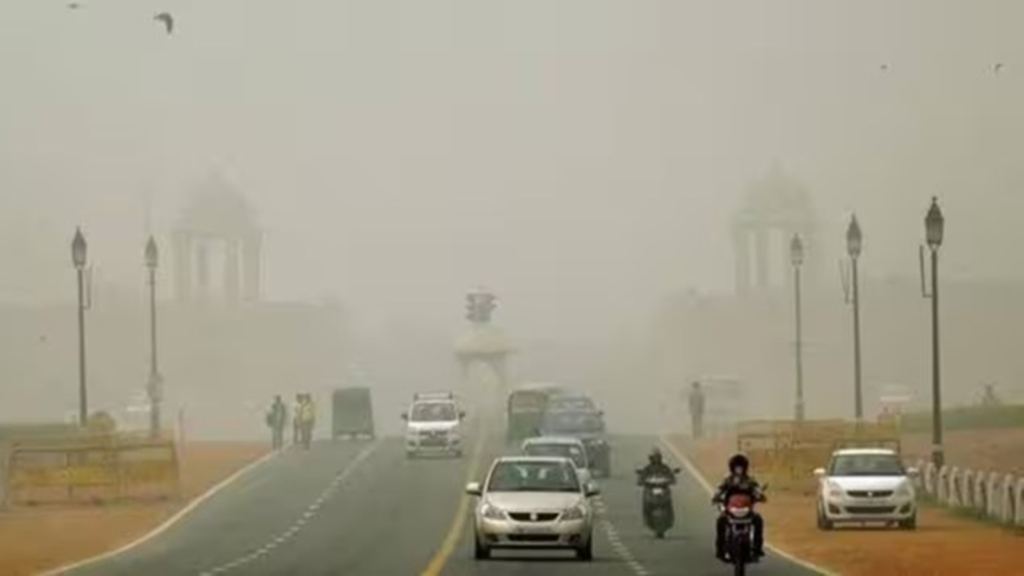Delhi’s Air Pollution crisis that has recently escalated to alarming levels. Just two days after the Diwali festival, known for its celebratory fireworks, the Air Quality Index (AQI) soared past 500, categorizing it as ‘Hazardous.’
The city’s residents are facing a health emergency as thick smog envelops the area, raising serious concerns about public safety and environmental health.
A Worsening Crisis: AQI Levels and Health Risks
As of early morning on November 1, 2024, Delhi’s AQI stood at a staggering 507, indicating a dire situation for air quality. The rapid increase in AQI figures has been shocking, with levels jumping from 327 to 507 within just 12 hours.
The PM2.5 levels in the National Capital Region (NCR) have been recorded at over 65 times higher than the safe limit prescribed by the World Health Organization (WHO). Such extreme pollution levels pose a significant risk to the health of the city’s inhabitants, particularly vulnerable populations such as children, the elderly, and those with pre-existing respiratory conditions.
Read :Environmental Alarms: Uncovering the Top 10 Most Polluted Nations
The implications of this pollution crisis extend beyond immediate health concerns. Exposure to such high levels of PM2.5—tiny particulate matter that can penetrate deep into the lungs and enter the bloodstream—can lead to a range of serious health issues, including respiratory infections, heart diseases, and even premature death.
Read : Toxic Foam Covers Yamuna River as Pollution Level Surges in Delhi
The WHO has set a safe limit for PM2.5 at 10 micrograms per cubic meter, yet Delhi’s air quality has reached levels that far exceed this benchmark, highlighting the urgent need for effective pollution control measures.
In various areas of Delhi, the air quality has been reported as ‘very poor,’ affecting numerous neighborhoods including Alipur, Anand Vihar, Ashok Vihar, and many others. This widespread deterioration of air quality not only affects daily life but also puts immense pressure on the city’s healthcare system, which is already strained due to other pressing public health challenges.
Post-Diwali Pollution: A Pattern of Crisis
The recent surge in air pollution can be largely attributed to the aftermath of Diwali celebrations, which typically involve the extensive use of firecrackers. Despite efforts by the government to ban or restrict the use of these pollutants, many residents continue to partake in the festivities with fireworks, leading to a sharp spike in air quality degradation.
This year, the AQI figures soared significantly post-Diwali, reflecting a recurring pattern in urban Indian cities where festivities are often marred by environmental consequences.
Kolkata also witnessed a deterioration in air quality, with AQI levels falling into the ‘poor’ category in several areas. Notably, PM2.5 measurements reached 288 in Ballygunge and 210 in Jadavpur, reinforcing the idea that the effects of celebratory air pollution are not confined to Delhi alone.
Other major cities like Mumbai and Chandigarh reported AQI levels indicative of poor air quality as well, further showcasing the widespread nature of this issue across the country.

In Mumbai, for instance, the AQI was recorded at 192, while cities in Haryana and Punjab also reported poor air quality readings. The impact of Diwali celebrations on air quality is a well-documented phenomenon, yet the scale of pollution this year, particularly in Delhi, is a cause for alarm. It begs the question of how such cultural practices can be reconciled with the urgent need to protect public health and the environment.
The Path Forward: Addressing Air Quality Concerns
The air pollution crisis in Delhi and other cities requires immediate action and long-term strategies to improve air quality and safeguard public health. Policymakers, environmental experts, and the general public must collaborate to develop solutions that address the root causes of air pollution, particularly during peak pollution periods like post-Diwali.
One effective approach could be to enhance public awareness campaigns about the detrimental effects of firecrackers on air quality. Encouraging alternative, eco-friendly ways to celebrate festivals could significantly reduce air pollution levels during these times. Moreover, stricter enforcement of existing regulations banning the use of firecrackers is essential to prevent further deterioration of air quality in urban areas.
Additionally, investment in public transportation infrastructure and promotion of electric vehicles could help reduce vehicular emissions, a significant contributor to urban air pollution. Expanding green spaces and urban forests can also play a crucial role in improving air quality by absorbing pollutants and providing cleaner air for residents.

On a governmental level, the implementation of stricter industrial emission standards and regular monitoring of air quality can help mitigate pollution levels. Collaborative efforts between state and central authorities are necessary to create comprehensive action plans that prioritize environmental health.
As Delhi grapples with this public health crisis, it is crucial for citizens to take personal responsibility by minimizing activities that contribute to pollution and advocating for cleaner air initiatives. Public engagement and community action can drive change and foster a culture of environmental responsibility.
The alarming AQI levels in Delhi post-Diwali highlight a pressing need for immediate action to combat air pollution. With PM2.5 levels surpassing WHO’s safe limits, it is imperative for residents, policymakers, and environmental advocates to work together to address the crisis. Sustainable solutions and public awareness are key to ensuring a healthier future for Delhi and other cities facing similar challenges.
Delhi’s air quality crisis serves as a stark reminder of the urgent need for collective action in protecting our environment and health, especially in the wake of cultural practices that can have severe consequences on air quality.
let’s enjoy few years on earth with peace and happiness….✍🏼🙏

